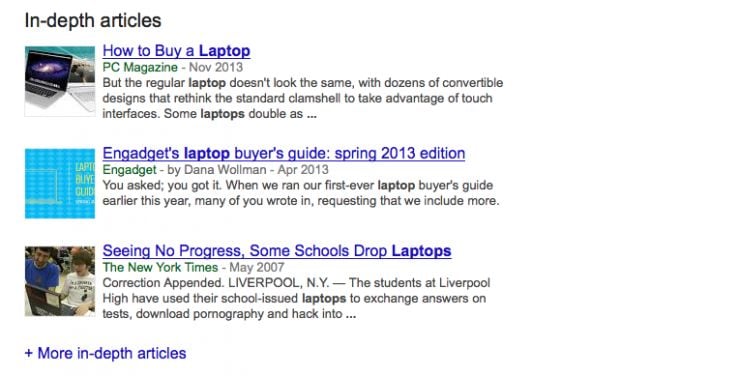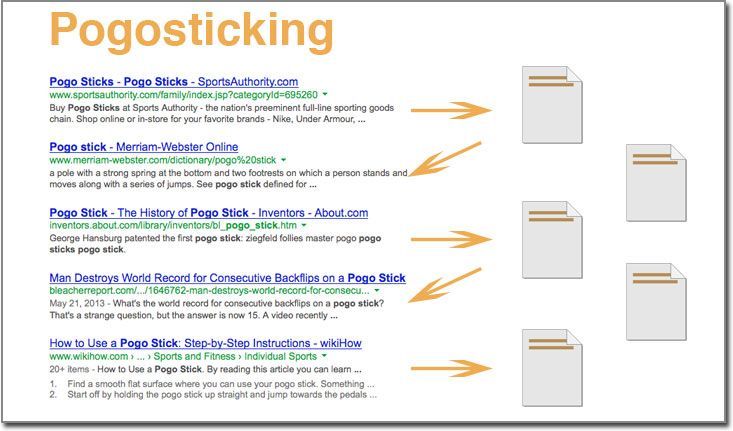
12 Ways to Increase Traffic From Google Without Building Links
Link building is hard, but it's not the only way to make traffic gains in Google's search results.
When I first started SEO, building links wasn't my strong suit. Writing outreach emails terrified me, and I had little experience creating killer content. Instead, I focused on the easy wins.
While off-page factors like links typically weigh more heavily than on-page efforts in Google's search results, SEOs today have a number of levers to pull in order to gain increased search traffic without ever building a link.
For experienced SEOs, many of these are established practices, but even the most optimized sites can improve in at least one or more of these areas.
1. In-depth articles
According to the MozCast Feature Graph, 6% of Google search results contain In-depth articles. While this doesn't seem like a huge numbers, the articles that qualify can see a significant increase in traffic. Anecdotally, we've heard reports of traffic increasing up to 10% after inclusion.

By adding a few signals to your HTML, your high quality content could qualify to appear. The markup suggested by Google includes:
- Schema.org Article markup – NewsArticle works too)
- Google+ Authorship
- Pagination and canonicalization best practices
- Logo markup
- First click free – for paywall content
While Google seems to favor authorities news sites for In-depth Article inclusion, most sites that may qualify don't have the proper semantic markup implemented.
2. Improving user satisfaction
Can you improve your Google rankings by improving the onsite experience of your visitors?
In many ways the answer is "yes," and the experience of several SEOs hints that the effect may be larger than we realize.
We know that Google's Panda algorithm punishes "low-quality" websites. We also know that Google likely measures satisfaction as users click on search results.
"… Google could see how satisfied users were. … The best sign of their happiness was the "long click" – this occurred when someone went to a search result, ideally the top one, and did not return."
-Stephen Levy from his excellent book In the Plex
The idea is called pogosticking, or return-to-SERP, and if you can reduce it by keeping satisfied visitors on your site (or at least not returning to Google to look for the answer somewhere else) many SEOs believe Google will reward you with higher positions in search results.
Tim Grice of Branded3 reports a saying they have at their SEO agency:
"If you have enough links to be in the top 5, you have enough links to be position 1″
While we have no direct evidence of pogosticking in Google's search results, we've seen enough patents, interviews and analysis to believe it's possibly one of the most underutilized techniques in SEO today.
3. Rich snippets from structured data
Google constantly expands the types of rich snippets it shows in search results, including events, songs, videos and breadcrumbs.
The first time I heard about structured data was from a presentation by Matthew Brown at MozCon in 2011. Matthew now works at Moz, and I'm happy to glean from his expertise. His Schema 101 presentation below is well worth studying.
If you're just getting started, check out this amazingly helpful Guide to Generating Rich Snippets from the folks at SEOgadget.
Two of our favorite types of markup for increasing clicks are videos and authorship, so we'll discuss each below.
4. Video optimization
Pixel for pixel, video snippets capture more search real estate than any other type of rich snippet, even more than authorship photos. Studies show our eyes go straight to them.
![]()
Eye-Tracking Google SERPs - 5 Tales of Pizza
Unlike author photos, video snippets are often easier to display and don't require connecting a Google+ account.
Video snippets generally require creating a video XML sitemap and adding schema.org video markup.
To simplify things, many third party services will take care of the technical details for you. Here at Moz we use Wistia, which creates a sitemap and adds schema.org markup automatically.
Pro tip: Both schema.org and XML sitemaps allow you to define the video thumbnail that appears in search results. As the thumbnail highly influences clicks, choose wisely.
Recommended reading: Getting Video Results in Google
5. Google authorship
Scoring the coveted author photo in Google search results doesn't guarantee more clicks, but getting the right photo can help your click-through rate in many results.
What makes a good author photo? While there are no rules, I've personally tested and studied hundreds of photos and found certain factors help:
- Use a real face, not a company logo, cartoon or icon
- High contrast colors. Because the photo is small, you want it to stand out with good separation between the background and foreground.
- Audience targeted. For example, young Disney fans are probably less likely to click on an old guy in a suit who looks like a financial adviser.

Google recently got more selective about the author photos it chooses to show, but if you implement authorship correctly you may find yourself in the 20% (according to MozCast) of all search results that include author photos.
6. Improving site speed
Improving site speed not only improves visitor satisfaction (see point #1) but it may also have a direct influence on your search rankings. In fact, site speed is one of the few ranking factors Google has confirmed.
One of the interesting things we learned this year, with help from the folks at Zoompf, is that actual page load speed may be far less important than Time to First Byte (TTFB). TTFB is the amount of time it takes a server to first respond to a request.

As important as page speed is for desktop search Google considers it even more important for mobile devices. Think about the last time you waited for a page to load on your cell phone with a weak signal.
"Optimizing a page's loading time on smartphones is particularly important given the characteristics of mobile data networks smartphones are connected to."
- Google Developers
Suggested tool: PageSpeed Insights
7. Smartphone SEO
Aside from speed, if your website isn't configured properly for smartphones, it probably results in lower Google search results for mobile queries. Google confirms that smartphone errors may result in lower mobile rankings.
What is a smartphone error? It could include:
- Redirecting visitors to the wrong mobile URL
- Embedding a video that doesn't play on a particular phone (Flash video on an iPhone, for example)
- Pop-ups that aren't easily closed on mobile
- Buttons or fonts that are too small on a mobile device
Google recommends making your site responsive, but many of the top brands in the world, including Apple.com, don't have responsive sites. Regardless, a good mobile experience is imperative.
8. Expanding your international audience
Does your website have traffic potential outside your existing country and/or language?
Our international experts like Aleyda Solis know this well, but folks inside the United States have been slow to target specific languages and countries with SEO.
Oftentimes, the opportunities for appearing in international search results are greater than staying within your own borders, and the competition sometimes less. To see if it's worth your while to make an investment, check out this International SEO Checklist by Aleyda (who is also a mobile SEO expert—it's so unfair!)

9. Social annotations with Google+
When you share content on Facebook and Twitter, your network basically sees it only when they are looking at Facebook and Twitter.
On the other hand, when you share content on Google+, your network can see it every time they search Google.
Google's own research shows that users fixate on social annotations, even when presented with videos and other types of rich snippets.
The easiest way to take advantage of this is to expand your Google+ network and share good content regularly and often. Rand Fishkin elegantly explains how to use Google+ to appear in the top of Google results every time.
Additionally, content shared through Google+ often ranks in regular search results, visible to everyone on the web, regardless of their social connections.
10. Snippet optimization
This goes back to basic meta tag and title tag optimization, but it's a good practice to keep in mind.
In the past two years, Google changed the maximum length of title tags so that it's no longer dependent on the number of characters, but on the number of pixels used, generally around 500 pixels in length. This keeps changing as Google tests new layouts.

Because 500 pixels is difficult to determine when writing most titles, best advice is still to keep your titles between 60-80 characters, or use an online snippet optimization tool to find your ideal title tag length.
Google also updated its advice on meta descriptions, further clarifying that duplicate meta descriptions are not a good idea. Matt Cutts tells us that if you can't make your descriptions unique for each page, it's better to have none at all.
"You can either have a unique meta tag description, or you can choose to have no meta tag description."
Google's Matt Cutts
Given that duplicate meta descriptions are one of the few HTML recommendations flags in Webmaster Tools, does this indicate Google treats repetitive meta descriptions as a negative ranking factor? Hmmm….
11. Updating fresh content
Websites that stop earning new links often lose ground in Google search results. At the same time, sites that never add new content or let their pages go stale can also fall out of favor.
Freshening your content doesn't guarantee a rankings boost, but for certain types of queries it definitely helps. Google scores freshness in different ways, and may include:
- Inception date
- The amount (%) your content changes
- How often you update your content
- How many new pages you create over time
- Changes to important content (homepage text) vs. unimportant content (footer links)

Recommended reading: 10 Illustrations on How Fresh Content Can Influence Rankings
12. Ongoing on-page SEO
The factors listed here only scratch the surface of earning more real estate in search results. Issues such as indexing, crawling, canonicalization, duplicate content, site architecture, keyword research, internal linking, image optimization and 1,000 other things can move ranking mountains.
The job of the Technical SEO becomes more complex each year, but we also have more opportunities now than ever.
It's easy to think nothing is new in SEO, or that SEO is easy, or that Google will simply figure out our sites. Nothing is further from reality.
The truth is, we have work to do.
The author's views are entirely their own (excluding the unlikely event of hypnosis) and may not always reflect the views of Moz.






Comments
Please keep your comments TAGFEE by following the community etiquette
Comments are closed. Got a burning question? Head to our Q&A section to start a new conversation.